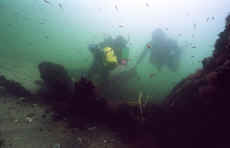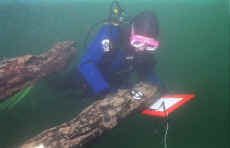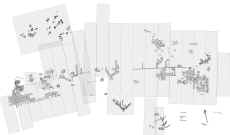EU project to preserve underwater cultural heritagePresenting European Community Culture 2000 Programme "Monitoring, Safeguarding and Visualizing North-European Shipwreck Sites" (MoSS)
This programme funds for the first time a project on underwater cultural heritage. The project deals with the monitoring, protecting, and visualizing of shipwrecks and their conditions. The project aims at telling Europeans about underwater cultural heritage and its need for protection. The project is based on four shipwrecks, all of them significant and important, showing a diversity of intercultural relationships throughout a long period of European history. The wrecks are in the Netherlands, Germany, Sweden, and Finland, representing different ship types. The oldest is from the 13th century and the youngest from the mid-19th century. The wrecks are in different underwater environments; in sea, lake, and brackish waters, and the conditions are both stable and unstable. The wrecks are all preserved extremely well; two of them are almost intact.
Burgzand Noord 10 Wreck, Netherlands, NISA/ROB Three themesThe project has three main themes: monitoring, safeguarding and visualizing shipwrecks.
The project will consist of fieldwork, web sites, publications, posters, leaflets, reports, articles, meetings, and seminars. One of the objectives, is to produce information not only to the general public but also to the experts in the area of protecting the cultural heritage. The aim is to awaken European peoples' interest in our common underwater cultural heritage and to have the general public participate in protecting the heritage. The wrecks of the project – ships that sailed on European waters – act as examples of maritime history as they tell us about the many local and international dimensions of the European culture. Funding and contactsThe years from 2001 to 2004 are notable years for the European underwater cultural heritage: it is the first time the Culture 2000 Programme funds an international shipwreck project. The name of the three-year project is "Monitoring, Safeguarding and Visualizing North-European Shipwreck Sites: Common European Underwater Cultural Heritage - Challenges for Cultural Resource Management" (MoSS), and six European countries participate in it. The project will be funded by the European Community Culture 2000 Programme. The budget of the project is about 1 157 000 euros in all. The grant from Culture 2000 Programme is about 690 000 euros. The Culture 2000 is a European Community programme that supports international cultural co-operation projects that involve organizers from several countries. The objectives are among other things to encourage co-operation, to promote the common European cultural heritage, and to disseminate the knowledge of the history and culture of the peoples of Europe. In 2001, it was the first time projects on sub-aquatic archaeology were especially called to take part in the program. The project is organized by:
Related link |



 Back to Nordic Underwater Archaeology
Back to Nordic Underwater Archaeology